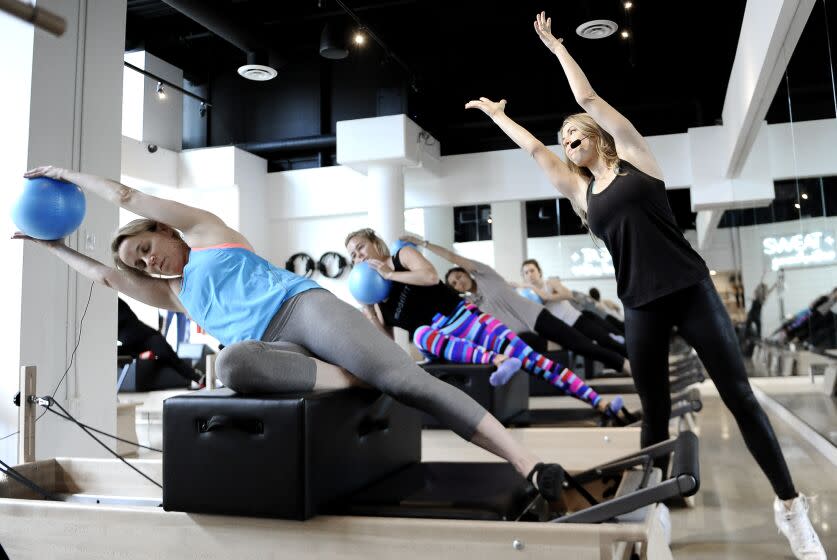Opinion: Who gets to be an 'L.A. Pilates girl'?

- Oops!Something went wrong.Please try again later.
In January, TikTok creator lizzyhopz went viral with a video in which she chanted: “L.A. Pilates girl, beige, white, ivory.” She was mocking the neutral palette typically seen in Pilates studios as boring interior design choices.
As a Pilates devotee, I thought of her lyrics during a recent workout. Everyone around me was a shade of beige, white or ivory. It made me wonder: Who gets to be an L.A. Pilates girl? An exercise that was intended to be based in community has become exclusive, from what I’ve seen, with mostly wealthy white women dominating Los Angeles’ Pilates culture. In a city known for fitness, people of color like me don’t always feel welcome in such spaces, and because they’re so expensive, some exercise outlets can feel out of reach.
There are various forms of Pilates. Some workouts only use mats, while what’s known as “reformer Pilates” includes a machine with a sliding seat. The practice has its origins in helping people with mobility challenges. Founder Joseph Pilates created his namesake workout in prison, where he was interned as a German prisoner of war by the British during World War I. Pilates’ focus was on rehabilitation: He created an early prototype of the reformer Pilates machine by attaching springs to sliding hospital beds so that injured patients who were unable to walk could have their own opportunities for physical movement. Later, in New York, his techniques caught on with dancers. His protege Kathleen Stanford Grant, a legend in Black dance history, emphasized inclusivity in her work. As Grant put it, “the Joe Pilates studio was open to all races, religions, political views and so forth. And that also goes in the work itself.”
Today classes offering different types of Pilates cost around $30 to $40 per class, while unlimited monthly packages range from $300 to $400 per month. This price point makes Pilates inaccessible for many. The only way I have been able to afford reformer Pilates classes, which are almost always offered through private studios, is through the fitness subscription service ClassPass, and using the discounted corporate rate at that.
Because it’s pricey, Pilates has gained an infamous reputation for being exclusive and white, deterring many of my friends who have expressed interest in the workout. It’s not meant for them, they believe. As an Asian American woman with a larger body size, I can understand. Often, I feel like a sore thumb among a sea of thin white women when I enter a Pilates class. The large mirrors don’t help. Sometimes it feels as though I get ignored by other classmates, such as when they look away when I smile at them. Perhaps I am imagining things, perhaps they were having a bad day, perhaps they didn’t want my presence to disturb their environment. But it’s a sign of how I often don’t feel a sense of belonging or camaraderie in these spaces.
What keeps me coming back to Pilates, however, is my love for the practice itself. The movements look graceful and simple to the outsider, but all Pilates practitioners know how much focus, strength and humility it takes to execute a move. And that’s just during class — much like the New York dancers of the mid-20th century, I’ve noticed improvements in technique, performance and rehabilitation that carries over to other exercise methods and sports that I do. Pilates has helped me lift heavier, stretch deeper in yoga and walk farther without pain.
Is there a way to make Pilates more accessible to all — both financially and socially? Harking back to Joseph Pilates' crafty spirit, I’ve seen TikTokers use benches, rowing machines and the like to create “makeshift” reformer Pilates machines of their own. There are also collectives such as Black Girl Pilates that support both Black female students and instructors. One of my go-to places, the Studio MDR (the most diverse of the studios I’ve attended), has hosted donation-based classes.
When fitness blogs and magazines speak about Pilates, there’s often discussion around Pilates aesthetics, such as what to wear for your workout, and body image, the kind of killer abs you can obtain. The imagery reinforces a standard thin white female as the ideal candidate for this exercise. But the more we shift our conversations around fitness to the benefits of athletic performance, rehabilitation and feeling better in our bodies (no matter the size), the more we can open up these spaces for everyone.
Amanda Walujono, a writer based in Los Angeles, is working on her debut novel. @misamandary
This story originally appeared in Los Angeles Times.

